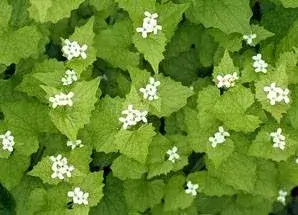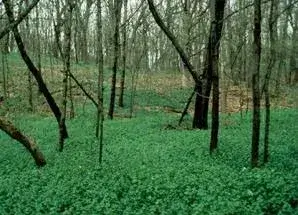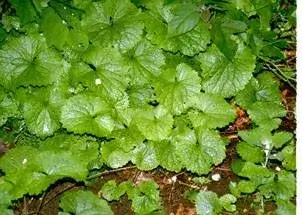
Garlic mustard (Alliaria petiolata) is an invasive herb that has spread throughout much of the United States over the past 150 years, becoming one of the worst invaders of forests in the American Northeast and Midwest. While it is usually found in the undergrowth of disturbed woodlots and forest edges, recent findings have shown that garlic mustard has the ability to establish and spread even in pristine areas. This spread has allowed it to become the dominant plant in the undergrowth of some forests, greatly reducing the diversity of all species. Garlic mustard is one of very few non-native plants to be able to successfully invade forest understories.

Garlic mustard is a non-native species originating from Europe and parts of Asia. It is believed that garlic mustard was introduced into North America for medicinal purposes and food. The earliest known report of it growing in the United States dates back to 1868 on Long Island, NY. It has since spread throughout the eastern United States and Canada as far west as Washington, Utah, and British Columbia.


Garlic mustard has a biennial life cycle, that is, it takes two years to fully mature and produce seeds. Seeds germinate in February to early March of the first year and grow into a short rosette by the middle of the summer. In the plant’s second year, a stalk develops, flowers form, and the plant dies by June. Siliques, four-sided seedpods, develop in May, containing small black seeds lined up in a row. On average, a garlic mustard plant will produce 22 siliques, each of which can contain as many as 28 seeds. A particularly vigorous plant may produce as many as 7,900 seeds (Nuzzo, 1993) although the average is more likely to be in the 600 seed range. The seeds generally germinate within one to two years, but may remain viable for up to five years in the seed bank. Seed dispersal is mainly by humans or wildlife carrying the seeds.

Identification of first year plants can be difficult; the task is made easier by smelling the garlic odor produced when the leaves of the plant are crushed. The basal leaves of an immature plant are dark-green and kidney shaped with round teeth (scalloped) along the edges; average size of the leaves is 6 to 10 cm in diameter. The petiole, or leaf stalk, of first year plants are 1 to 5 cm long. In its second year, the alternating stem leaves become more triangular shaped, 1 to 5 cm long, and have sharper teeth, with leaves becoming gradually smaller towards the top of the stalk. Leaf stalks of mature plants are hairy. As with the younger plants, second year plants have a garlic odor when crushed but the odor is less obvious with increasing age.
Garlic mustard flowers arrive in early April and die by June. Flowers develop on an unbranched (occasionally weakly branched) stalk and have 4 small white petals arranged symmetrically. Flowers are approximately 6 to 7 mm in diameter with 3 to 6 mm petals. Individual flowers contains six stamens, two shorter and four longer. Mature flowering plants reach 3.5 feet tall, although shorter flowering specimens may be found.

Garlic mustard has the potential to form dense stands that choke out native plants in the understory by controlling light, water, and nutrient resources. Plants most affected by these dense stands are herbaceous species that occur in similar moist soil forest habitats and grow during the spring and early summer season. Although unsupported by the lack of long-term research into garlic mustard impacts, the plant has been circumstantially tied to decreased native herbaceous species richness in invaded forests. Researchers have found that garlic mustard is allelopathic (it releases chemicals that hinder the growth of other plant species) and has inhibited growth of both grasses and herbs in laboratory settings (Michigan State University, 2008). Some researchers also believe that these compounds may hinder the beneficial relationships some plant species have with soil fungi (Roberts and Anderson, 2001). Experimental trials have shown that removal of garlic mustard leads to increased diversity of other species, including annuals and tree seedlings (MSU, 2008).

Other aspects of the forest ecosystem may be altered due to the change in the vegetative community tied to garlic mustard invasion. While the impacts to wildlife are not completely understood, altering the plant diversity can cause a change in leaf litter availability, potentially impacting salamanders and mollusks (MSU, 2008). Insects, including some butterflies, may be affected through the lost diversity in plants and loss of suitable egg-laying substrate (MSU, 2008). Garlic mustard may also affect the tree composition by creating a selective barrier that some seedlings, such as the chestnut oak (Quercus prinus), may not be able to overcome (MSU, 2008). These changes in tree composition could have significant long-term effects.

There are few effective natural enemies of garlic mustard in North America. Herbivores, or animals that eat plant material, such as deer (Odocoileus virginianus) and woodchucks (Marmota monax) only remove up to 2% of the leaf area in a stand of garlic mustard (Evans et al. 2005). This level of herbivory is ineffective in controlling reproduction or survival of garlic mustard. Although 69 herbivorous insects have been found to be associated with garlic mustard in Europe, less than a dozen have been found on North American infestations of the species (Hinz and Gerber, 1998).
Manual removal of plant has been shown to prevent the spread of garlic mustard. Pulling by hand must remove at least the upper half of the root to prevent a new stalk from forming; this is most easily accomplished in the spring when the soil is soft. Hand-pulling should be performed before seeds are formed and needs to be continued for up to five years in order to deplete any established seed bank. This method works best in smaller pockets of invasion or in areas recently invaded to help prevent the development of a seed bank.
Chemical applications can also be effective for controlling garlic mustard, particularly in areas too large for removal by hand. In dense stands where other plant species are not present, a glyphosate-based herbicide such as Roundup® can be an effective method for removal. Glyphosate herbicides are non-selective, so caution must be used when non-target species are in the area. Chemical applications are most affective during the spring (March-April) when garlic mustard is one of the few plants actively growing. Fall applications may be used; however other plant species still in their growing season may be harmed. Readers are advised to check with local regulatory agencies to determine the regulations involved with chemical treatments.
The best method for controlling garlic mustard, or any other invasive plant, is to prevent its establishment. Disturbances in the forest understory that would allow for rapid invasion should be minimized. This would include limiting foot traffic, grazing, and erosion-causing activities. Monitoring the forest understory and removing any garlic mustard plants as soon as they are introduced will help to prevent the establishment and spread of this invader.
This map shows confirmed observations (green points) submitted to the NYS Invasive Species Database. Absence of data does not necessarily mean absence of the species at that site, but that it has not been reported there. For more information, please visit iMapInvasives.
Hinz HL, Gerber E. 1998. Investigations on potential biological control agents of garlic mustard, Alliaria petiolata (Bieb. Cavara & Grande). Annual Report for 1998. CABI Bioscience, Delemont, Switzerland.
Nuzzo VA. 1993. Distribution and spread of the invasive biennial garlic mustard (Alliaria petiolata) in North America, pp. 137-146. In McNight BN (ed.). Biological Pollution: The Control and Impact of Invasive Exotic Species. Indiana Academy of Science, Indianapolis.
Roberts KJ, Anderson RC. 2001. Effect of Garlic Mustard [Alliaria Petiolata (Beib. Cavara & Grande)] Extracts on Plants and Arbuscular Mycorrizal (AM) Fungi. American Midland Naturalist, 146:146-152.
